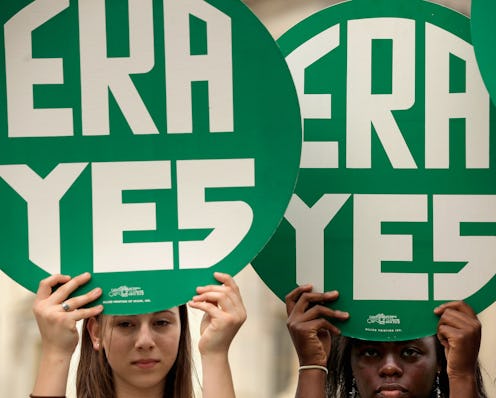Women's Equality Day is on Wednesday, but we still don't have an Equal Rights Amendment. Written by feminists Alice Paul and Crystal Eastman and initially introduced to Congress in 1923, the ERA should have been a landmark piece of legislation for gender equality and equal protection under the law. However, the ERA did not pass through Congress until 1972, and when it finally did, it was sent out to the states with a seven-year deadline for ratification — a deadline that was eventually extended to 1982. Despite this extension, the amendment was three states short of its required 38 in 1982, and even now, following numerous reintroductions, Congress still hasn't approved the ERA — why is that?
It's certainly not for a lack of trying. In 2013, Democratic Sen. Robert Menendez reintroduced the ERA as S. J. Res. 10, and last summer, Democratic Reps. Carolyn Maloney and Jackie Speier stood outside the Supreme Court to once again call for Constitutional protection of gender equality. For several years, Maloney has been pursuing two key strategies to get the ERA passed, once and for all. She has introduced the "start-over" ERA in multiple sessions of Congress, which would essentially set the ratification count back at zero and restart the ratification process. But Maloney has also lent her support to the "three state" strategy, which would result in the addition of the ERA to the Constitution as soon as three additional states — the number missing back in 1982 — ratified it. While this is certainly a more feasible option than starting over, there have also been debates about such a strategy's constitutionality.
Clearly, people are pushing for the ERA to become the 28th Amendment to the Constitution — and many people seem to believe that it already is — so why hasn't Congress added it yet? Part of the problem has to do with the ratification deadline. On March 8, 2011, a group of representatives introduced legislation to eliminate the deadline imposed by Congress for the ratification of the ERA, but that legislation — though officially received by the House of Representatives in the form of House Memorial 7 — was referred to the House's Committee on the Judiciary and never actually passed.
The other problem has to do with a lack of momentum. As Barbara Hannah Grufferman wrote for The Huffington Post back in 2011, "Complacency will kill the Equal Rights Amendment, and we need to change the tone of the discourse." Given that, according to Speier, 70 percent of people polled already think the amendment is in the Constitution, pro-ERA discourse and movements need to become more visible. If Congress is not held accountable on this issue — and that means writing to representatives and senators about removing the ratification deadline — then the ERA will continue to be stalled.
Amending the Constitution is not easy. An amendment has not been added to the Constitution in 23 years, but feminists need to make it explicitly clear that existing constitutional amendments, like the 14th and the 19th, are not sufficient to provide and ensure sex equality under the law.
